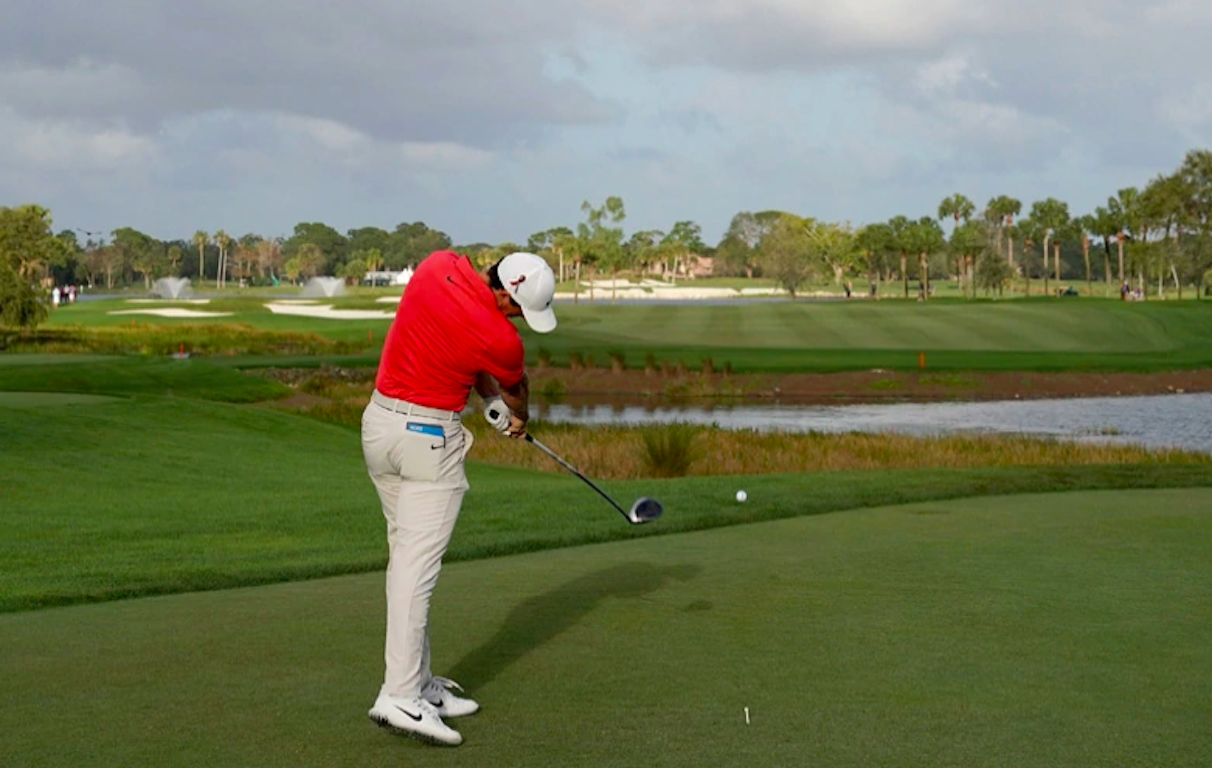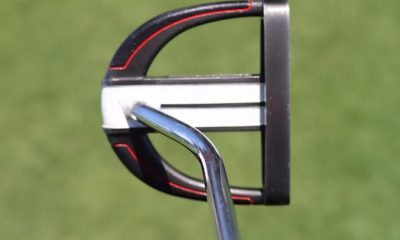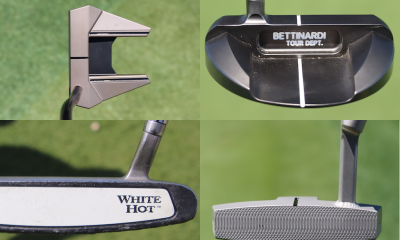Opinion & Analysis
The Wedge Guy: Building a stronger golf swing

Golf fitness has become a pretty big topic over the past few years, and not just for the guys and ladies on the professional tours. There are plenty of articles, blogs, podcasts and products totally focused on getting your body golf-ready.
As we all age, of course, we naturally lose muscle tone and strength, but also flexibility. For the most part, our culture puts most of us in jobs that are relatively “movement-free” in that much of our days are spent behind a desk and sitting. Neither are very good for your golf game.
If your best golf is important to you, there is no question that improving your flexibility and building stronger, faster muscles can help you become a better player, but there is definitely a right and wrong way to do that. In golf, we don’t really care about conventional muscle strength, such as that required to lift heavy weights. After all, a golf club weights much less than a pound. What we are after in golf conditioning is S-P-E-E-D and endurance. We want our muscles to be of a quick-fire capability and we must do that within a framework of flexibility and range of motion. A strong and powerful golf swing requires a full range of motion and very precise and coordinated movements of the body core, arms and hands/wrists. The faster you can do this, the more clubhead speed you develop – it’s really THAT simple.
Let me begin by stating my opinion on distance. Unless you are playing a driver that’s over 4-5 years old, significantly more distance is not likely for sale in the driver rack. The same goes for the iron selection.
The secret to more distance lies in improving your quality of contact and strength training. The simple fact is that better fundamentals come through instruction and practice. And here are my top five workouts to help you build more clubhead speed:
• Stretching. This applies to all golfers but particularly, but us older guys and girls would benefit greatly by daily stretching to improve our golf power. Of particular importance are the torso muscles and the large muscles in the legs and shoulders. Read up on this subject and you’ll find a wealth of information on stretching exercises specifically designed for the golf swing. A few minutes a day can make a world of difference pretty quickly.
• Core Training. Strengthening the big muscles of the body core is hugely beneficial to golf swing power. But, as I mentioned, what you are after is S-P-E-E-D, not brute strength. And again, there are a number of published exercise routines and techniques for achieving a stronger body core. An internet search will keep you reading and learning for hours.
• “Off Side” Strength. The golf swing has to be led by a strong “front side” pull, and that means we have to rely on our “off” hand for power. For right handed people, that means you should bias your strength training to your left side so that it can achieve more of a balance. I like to do this with a weighted club (there are many on the market), and swing it left side only to build that pull-through power.
• Release Strength. The “secret” power move in the golf swing is a strong rotation of the hands and forearms through the impact zone. The wrists do not create power in the swing by unhinging – they do it by rotating the club through impact in sync with the rotation of the body core. It does no good to develop core rotational speed if your hand rotation cannot keep up. Conversely, of course, fast hands with a slow body core will be limited in power as well. You can keep a light dumbbell in your office and/or living room to do simple rotation exercises while you are on the phone or watching TV. It WILL pay off.
• Golf Swing Speed. This has become a hot topic in golf fitness and there are several very good speed trainers out there. As I mentioned, there is no better golf swing strengthening exercise than to swing a weighted club. But go with the lighter ones and make your workout one of more and faster reps with less weight. Heavier weights and less reps build big muscles and lead to more fatigue and post-workout soreness and recovery. You don’t want that. Fifty to a hundred swings every afternoon/morning with one of these speed trainers will work wonders. And while you’re doing those, focus on your fundamentals – posture, grip, extension back and through, rotation through impact – the things that will build power and distance.
So, there you have my top five ways to improve your distance through the bag, while also actively combatting the natural effects of getting older. If golf is important to you, isn’t it worth giving your “golf health” a few minutes a day?
- LIKE103
- LEGIT19
- WOW3
- LOL3
- IDHT0
- FLOP4
- OB2
- SHANK22
19th Hole
Vincenzi’s 2024 Zurich Classic of New Orleans betting preview

The PGA TOUR heads to New Orleans to play the 2023 Zurich Classic of New Orleans. In a welcome change from the usual stroke play, the Zurich Classic is a team event. On Thursday and Saturday, the teams play best ball, and on Friday and Sunday the teams play alternate shot.
TPC Louisiana is a par 72 that measures 7,425 yards. The course features some short par 4s and plenty of water and bunkers, which makes for a lot of exciting risk/reward scenarios for competitors. Pete Dye designed the course in 2004 specifically for the Zurich Classic, although the event didn’t make its debut until 2007 because of Hurricane Katrina.
Coming off of the Masters and a signature event in consecutive weeks, the field this week is a step down, and understandably so. Many of the world’s top players will be using this time to rest after a busy stretch.
However, there are some interesting teams this season with some stars making surprise appearances in the team event. Some notable teams include Patrick Cantlay and Xander Schauffele, Rory McIlroy and Shane Lowry, Collin Morikawa and Kurt Kitayama, Will Zalatoris and Sahith Theegala as well as a few Canadian teams, Nick Taylor and Adam Hadwin and Taylor Pendrith and Corey Conners.
Past Winners at TPC Louisiana
- 2023: Riley/Hardy (-30)
- 2022: Cantlay/Schauffele (-29)
- 2021: Leishman/Smith (-20)
- 2019: Palmer/Rahm (-26)
- 2018: Horschel/Piercy (-22)
- 2017: Blixt/Smith (-27)
2024 Zurich Classic of New Orleans Picks
Tom Hoge/Maverick McNealy +2500 (DraftKings)
Tom Hoge is coming off of a solid T18 finish at the RBC Heritage and finished T13 at last year’s Zurich Classic alongside Harris English.
This season, Hoge is having one of his best years on Tour in terms of Strokes Gained: Approach. In his last 24 rounds, the only player to top him on the category is Scottie Scheffler. Hoge has been solid on Pete Dye designs, ranking 28th in the field over his past 36 rounds.
McNealy is also having a solid season. He’s finished T6 at the Waste Management Phoenix Open and T9 at the PLAYERS Championship. He recently started working with world renowned swing coach, Butch Harmon, and its seemingly paid dividends in 2024.
Keith Mitchell/Joel Dahmen +4000 (DraftKings)
Keith Mitchell is having a fantastic season, finishing in the top-20 of five of his past seven starts on Tour. Most recently, Mitchell finished T14 at the Valero Texas Open and gained a whopping 6.0 strokes off the tee. He finished 6th at last year’s Zurich Classic.
Joel Dahmen is having a resurgent year and has been dialed in with his irons. He also has a T11 finish at the PLAYERS Championship at TPC Sawgrass which is another Pete Dye track. With Mitchell’s length and Dahmen’s ability to put it close with his short irons, the Mitchell/Dahmen combination will be dangerous this week.
Taylor Moore/Matt NeSmith +6500 (DraftKings)
Taylor Moore has quickly developed into one of the more consistent players on Tour. He’s finished in the top-20 in three of his past four starts, including a very impressive showing at The Masters, finishing T20. He’s also finished T4 at this event in consecutive seasons alongside Matt NeSmith.
NeSmith isn’t having a great 2024, but has seemed to elevate his game in this format. He finished T26 at Pete Dye’s TPC Sawgrass, which gives the 30-year-old something to build off of. NeSmith is also a great putter on Bermudagrass, which could help elevate Moore’s ball striking prowess.
- LIKE8
- LEGIT3
- WOW1
- LOL1
- IDHT0
- FLOP3
- OB1
- SHANK2
19th Hole
Vincenzi’s 2024 LIV Adelaide betting preview: Cam Smith ready for big week down under

After having four of the top twelve players on the leaderboard at The Masters, LIV Golf is set for their fifth event of the season: LIV Adelaide.
For both LIV fans and golf fans in Australia, LIV Adelaide is one of the most anticipated events of the year. With 35,000 people expected to attend each day of the tournament, the Grange Golf Club will be crawling with fans who are passionate about the sport of golf. The 12th hole, better known as “the watering hole”, is sure to have the rowdiest of the fans cheering after a long day of drinking some Leishman Lager.
The Grange Golf Club is a par-72 that measures 6,946 yards. The course features minimal resistance, as golfers went extremely low last season. In 2023, Talor Gooch shot consecutive rounds of 62 on Thursday and Friday, giving himself a gigantic cushion heading into championship Sunday. Things got tight for a while, but in the end, the Oklahoma State product was able to hold off The Crushers’ Anirban Lahiri for a three-shot victory.
The Four Aces won the team competition with the Range Goats finishing second.
*All Images Courtesy of LIV Golf*
Past Winners at LIV Adelaide
- 2023: Talor Gooch (-19)
Stat Leaders Through LIV Miami
Green in Regulation
- Richard Bland
- Jon Rahm
- Paul Casey
Fairways Hit
- Abraham Ancer
- Graeme McDowell
- Henrik Stenson
Driving Distance
- Bryson DeChambeau
- Joaquin Niemann
- Dean Burmester
Putting
- Cameron Smith
- Louis Oosthuizen
- Matt Jones
2024 LIV Adelaide Picks
Cameron Smith +1400 (DraftKings)
When I pulled up the odds for LIV Adelaide, I was more than a little surprised to see multiple golfers listed ahead of Cameron Smith on the betting board. A few starts ago, Cam finished runner-up at LIV Hong Kong, which is a golf course that absolutely suits his eye. Augusta National in another course that Smith could roll out of bed and finish in the top-ten at, and he did so two weeks ago at The Masters, finishing T6.
At Augusta, he gained strokes on the field on approach, off the tee (slightly), and of course, around the green and putting. Smith able to get in the mix at a major championship despite coming into the week feeling under the weather tells me that his game is once again rounding into form.
The Grange Golf Club is another course that undoubtedly suits the Australian. Smith is obviously incredibly comfortable playing in front of the Aussie faithful and has won three Australian PGA Championship’s. The course is very short and will allow Smith to play conservative off the tee, mitigating his most glaring weakness. With birdies available all over the golf course, there’s a chance the event turns into a putting contest, and there’s no one on the planet I’d rather have in one of those than Cam Smith.

Louis Oosthuizen +2200 (DraftKings)
Louis Oosthuizen has simply been one of the best players on LIV in the 2024 seas0n. The South African has finished in the top-10 on the LIV leaderboard in three of his five starts, with his best coming in Jeddah, where he finished T2. Perhaps more impressively, Oosthuizen finished T7 at LIV Miami, which took place at Doral’s “Blue Monster”, an absolutely massive golf course. Given that Louis is on the shorter side in terms of distance off the tee, his ability to play well in Miami shows how dialed he is with the irons this season.
In addition to the LIV finishes, Oosthuizen won back-to-back starts on the DP World Tour in December at the Alfred Dunhill Championship and the Mauritus Open. He also finished runner-up at the end of February in the International Series Oman. The 41-year-old has been one of the most consistent performers of 2024, regardless of tour.
For the season, Louis ranks 4th on LIV in birdies made, T9 in fairways hit and first in putting. He ranks 32nd in driving distance, but that won’t be an issue at this short course. Last season, he finished T11 at the event, but was in decent position going into the final round but fell back after shooting 70 while the rest of the field went low. This season, Oosthuizen comes into the event in peak form, and the course should be a perfect fit for his smooth swing and hot putter this week.

- LIKE12
- LEGIT3
- WOW1
- LOL1
- IDHT0
- FLOP1
- OB1
- SHANK1
Opinion & Analysis
The Wedge Guy: What really makes a wedge work? Part 1

Of all the clubs in our bags, wedges are almost always the simplest in construction and, therefore, the easiest to analyze what might make one work differently from another if you know what to look for.
Wedges are a lot less mysterious than drivers, of course, as the major brands are working with a lot of “pixie dust” inside these modern marvels. That’s carrying over more to irons now, with so many new models featuring internal multi-material technologies, and almost all of them having a “badge” or insert in the back to allow more complex graphics while hiding the actual distribution of mass.
But when it comes to wedges, most on the market today are still single pieces of molded steel, either cast or forged into that shape. So, if you look closely at where the mass is distributed, it’s pretty clear how that wedge is going to perform.
To start, because of their wider soles, the majority of the mass of almost any wedge is along the bottom third of the clubhead. So, the best wedge shots are always those hit between the 2nd and 5th grooves so that more mass is directly behind that impact. Elite tour professionals practice incessantly to learn to do that consistently, wearing out a spot about the size of a penny right there. If impact moves higher than that, the face is dramatically thinner, so smash factor is compromised significantly, which reduces the overall distance the ball will fly.
Every one of us, tour players included, knows that maddening shot that we feel a bit high on the face and it doesn’t go anywhere, it’s not your fault.
If your wedges show a wear pattern the size of a silver dollar, and centered above the 3rd or 4th groove, you are not getting anywhere near the same performance from shot to shot. Robot testing proves impact even two to three grooves higher in the face can cause distance loss of up to 35 to 55 feet with modern ‘tour design’ wedges.
In addition, as impact moves above the center of mass, the golf club principle of gear effect causes the ball to fly higher with less spin. Think of modern drivers for a minute. The “holy grail” of driving is high launch and low spin, and the driver engineers are pulling out all stops to get the mass as low in the clubhead as possible to optimize this combination.
Where is all the mass in your wedges? Low. So, disregarding the higher lofts, wedges “want” to launch the ball high with low spin – exactly the opposite of what good wedge play requires penetrating ball flight with high spin.
While almost all major brand wedges have begun putting a tiny bit more thickness in the top portion of the clubhead, conventional and modern ‘tour design’ wedges perform pretty much like they always have. Elite players learn to hit those crisp, spinny penetrating wedge shots by spending lots of practice time learning to consistently make contact low in the face.
So, what about grooves and face texture?
Grooves on any club can only do so much, and no one has any material advantage here. The USGA tightly defines what we manufacturers can do with grooves and face texture, and modern manufacturing techniques allow all of us to push those limits ever closer. And we all do. End of story.
Then there’s the topic of bounce and grinds, the most complex and confusing part of the wedge formula. Many top brands offer a complex array of sole configurations, all of them admittedly specialized to a particular kind of lie or turf conditions, and/or a particular divot pattern.
But if you don’t play the same turf all the time, and make the same size divot on every swing, how would you ever figure this out?
The only way is to take any wedge you are considering and play it a few rounds, hitting all the shots you face and observing the results. There’s simply no other way.
So, hopefully this will inspire a lively conversation in our comments section, and I’ll chime in to answer any questions you might have.
And next week, I’ll dive into the rest of the wedge formula. Yes, shafts, grips and specifications are essential, too.
- LIKE34
- LEGIT7
- WOW1
- LOL1
- IDHT2
- FLOP3
- OB1
- SHANK3
-

 19th Hole2 weeks ago
19th Hole2 weeks agoDave Portnoy places monstrous outright bet for the 2024 Masters
-

 19th Hole4 days ago
19th Hole4 days agoJustin Thomas on the equipment choice of Scottie Scheffler that he thinks is ‘weird’
-

 19th Hole2 weeks ago
19th Hole2 weeks agoTiger Woods arrives at 2024 Masters equipped with a putter that may surprise you
-

 19th Hole4 days ago
19th Hole4 days ago‘Absolutely crazy’ – Major champ lays into Patrick Cantlay over his decision on final hole of RBC Heritage
-

 19th Hole2 weeks ago
19th Hole2 weeks agoTwo star names reportedly blanked Jon Rahm all week at the Masters
-

 19th Hole1 week ago
19th Hole1 week agoReport: LIV Golf identifies latest star name they hope to sign to breakaway tour
-

 19th Hole2 weeks ago
19th Hole2 weeks agoNeal Shipley presser ends in awkward fashion after reporter claims Tiger handed him note on 8th fairway
-

 19th Hole1 week ago
19th Hole1 week agoBrandel Chamblee has ‘no doubt’ who started the McIlroy/LIV rumor and why
























Bob Jones
Nov 21, 2022 at 10:52 am
Regarding wrist rotation. The wrists are not built to rotate. They can hinge in the X-axis and Y-axis, but they cannot rotate in the Z-axis. It is the forearms that rotate and the wrists and hands follow. This is not a trivial distinction, and it is not a matter of opinion. It is basic functional human anatomy. Actively rotating the forearms in the golf swing means the rotation has be perfectly timed for the clubhead to be square at impact. Without LOTS of practice this is hard to do, and even then there will be days when it just doesn’t work. All rotation in the golf swing should occur in the shoulder joints.
Paul Runyan
Nov 20, 2022 at 4:21 pm
I work out with a Swing Emulator and have for years.
Basically it’s a weight stack of plates of 10 to 100 pounds.
You can adjust it for height, arm length, length of swing and Swing Plane.
3 sets of 15 at 40 lbs is harder than it looks. And l, do it barefooted to feel the pressure in the feet and toes! One arm swings and opposite swings aren’t a picnic either. BUT!…
At age 65 my Swing speed was around 115. I used to push it to 80 lbs but backed off to 40 and 50 pounds. I still can get the club to parallel at age 70. Not bad.
I agree with the author, 90% of it, but for older players, pushing heavy weights can have a diminishing return and too much rest is needed especially after the 2nd day of using this machine. I’d rather go lighter and play more golf.
I can usually out drive most senior and younger guys and have but what’s the point if you can’t putt or have a short game!!
My drivers are optimized for me and I use standard Mizuno irons, Mizuno Mp 69 and JPX 921 Tours. Switched over to lighter LPGA iron shafts, 950 gh and wondering why I didn’t do this 10 years earlier!
Josh
Nov 4, 2022 at 2:59 pm
Wow….I have respect for Terry and think he is a wealth of knowledge on many things. Strength and conditioning, however, is not one of them. To build a “stronger swing” and increase club head speed, the golfer needs to increase strength by lifting weights heavier than they are used to lifting. All he said was you need some strength, but not “brute” strength. This is extremely vague. The golf club may not be that heavy when it is static, bit when you are moving it 80-100 mph, it becomes a LOT HEAVIER and you need to be strong to handle that speed, otherwise injuries occur. Terry, take a look at the longest hitters in the world…do you think they go into the gym and say to themselves “I don’t need any brute strength”?
sjn
Nov 3, 2022 at 7:07 pm
fifty to 100 hubdered swings every day wtih speed trainers? the only thing you will pick up like that is injuries .
sjn
Nov 5, 2022 at 9:24 am
LOL should read what I type ; should ’50 to 100 faast swings every day’ . 20/30 max twice or thre times a week is plenty , and only then if you you are strong and fexible.
Chip2win
Nov 3, 2022 at 6:38 am
Strength=SPEED. You need to be strong to hit it long. ?